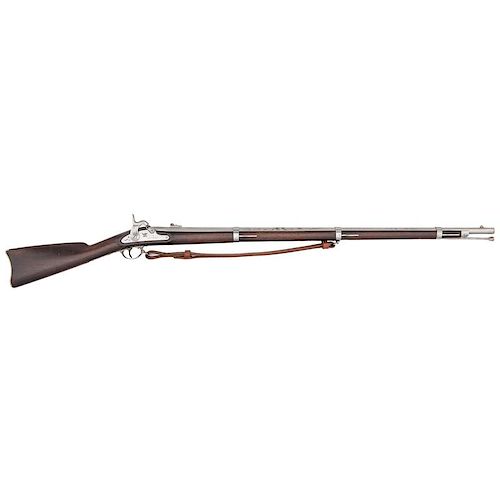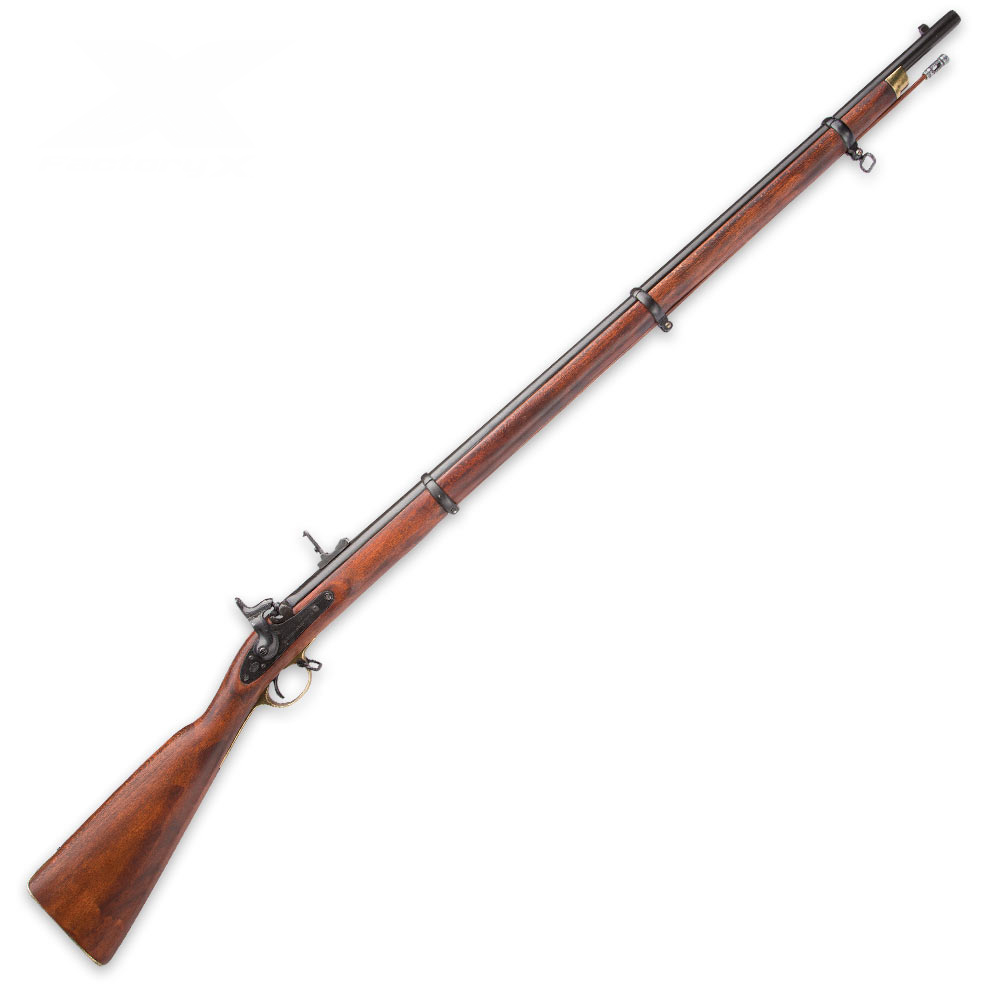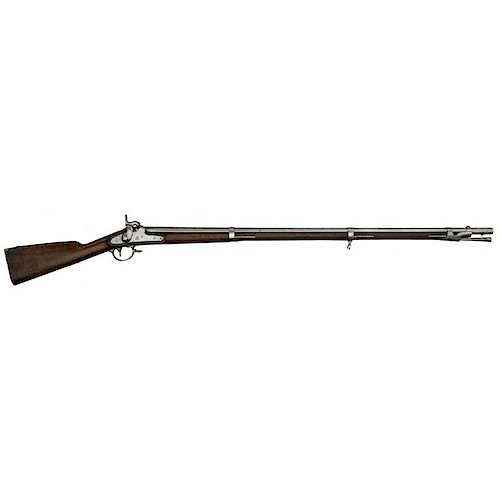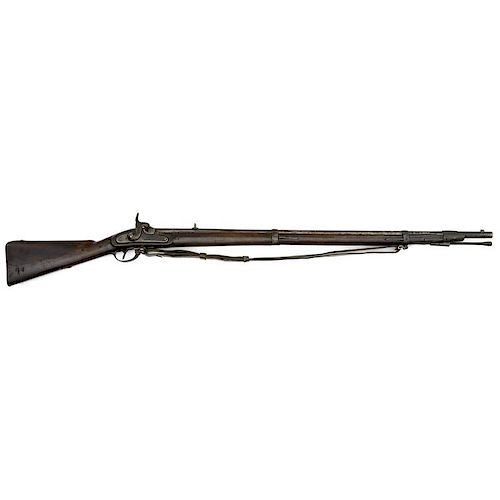Civil War Arms and Equipment
Exploring the weapons and technology of the Civil WarCivil War Muskets
Rifled muskets were the most widely used weapons during the American Civil War. The American-made Springfield Model 1861 was the mostly widely used and was adopted by the Army to replace the .69-caliber smoothbore musket. In addition to the Springfield, was the British Pattern 1853 Enfield was also very popular, followed closely by the Lorenz Rifle. There were also many technological advances in weaponry that occurred during the Civil War, rendering the weapons far more lethal and contributing to the enormous casualties of that war.
The Model 1861 Springfield
The Model 1861 was the standard rifle-musket used throughout the war. Made primarily by the Springfield Armory, the rifle-musket was a single-shot muzzleloaded weapon. The powder in the gun was ignited via a percussion cap which was struck by the hammer when the trigger was pulled. An estimated one million Model 1861-type muskets were manufactured during the war. The barrel was forty inches long, firing a .58 caliber Minié ball, and the total weight was approximately nine pounds. The Springfield had an effective range of 200 to 300 yards and troops were able to fire at a rate of three aimed shots per minute while maintaining accuracy.
The rifle-musket was equipped with a square socket bayonet and was aimed using flip-up leaf sights and cost twenty dollars to manufacture at the Armory. Overwhelmed by the demand, the armory opened its weapons patterns up to twenty private contractors including Colt.
The Model 1853 Enfield
The second most widely used weapon of the Civil War was the British Enfield three-band, single-shot, muzzle-loading musket. It was also the standard weapon for the British army between 1853-1867. American soldiers liked it because its .577 cal. barrel allowed the use of .58 cal. ammunition used by both Union and Confederate armies. Originally produced at the Royal Small Arms Factory at Enfield, England, approximately 900,000 of these muskets were imported during 1861-1865. Its overall length totaled 55 1/4 inches and weighed about 9 pounds. By1865, more than 300,000 three-band Pattern 1853 Enfield rifle-muskets served the Confederacy in almost every engagement in all theaters.
U.S. Model 1842 Springfield Musket
The Model 1842 Springfield musket was produced at both the Harpers Ferry and Springfield Armories from 1844 to 1855. The musket weighed about 10lbs and the 42″ barrel was a smoothbore and came in .69 caliber.
The Springfield Armory produced 172,000 while Harper’s Ferry produced about 103,000 of these muskets between 1844 and 1855. In the later part of the 1850’s, many of thes muskets were altered by adding rifling and a long range rear sight. These muskets have the distinction of being the first regulation percussion firearm manufactured in a national armory and the first U.S. firearm manufactured with interchangeable components.
1854 Austrian Lorenz Rifle
Due to a shortage of guns, approximately 350,000 Lorenz rifles were imported from Austria by both Union and Confederate governments. This rifle was a muzzleloader that used a percussion cap for ignition. The bullets fired by this rifle were inferior to the mine ball and the barrels were inconsistent in quality making these poorly performing weapons. Developed by the Austrian army to replace their older infantry muskets, the accepted design in 1854 utilized an advanced percussion ignition system summited by Josef Lorenz, a Viennese gunsmith. Lorenz rifles in the Civil War were generally used with .54 caliber cartridges, were about 53″ in length with a 37.5″ barrel.
Ammunition
Minie Ball
The Minié ball, or Minie ball, is a type of bullet used extensively in the American Civil War. The muzzle-loading rifle bullet was named after its co-developer, Claude-Étienne Minié. The bullet would expand when firing, and the bullet’s outside would catch the rifling, adding the spin to the bullet. This made the bullet extremely accurate and it also caused it to travel far distances. This would cause more deaths to Civil War soldiers because the tactics remained the same. Upon impact, the minie ball was hard enough to pierce the skin, but after it pierced, it would shatter. This made removing the bullet very difficult. Most soldiers had to be amputated to prevent infection. However, they would still get infected because the doctors used unclean equipment. The Civil War generals would be slow to realize this battlefield threat and not change strategies accordingly. More men would die.
Buck and Ball
Buck and ball was a common load for muskets, and was in the early days of the Civil War. The load usually consisted of a .50 to .75 caliber round lead musket ball (.69 caliber for the “Brown Bess” musket) that was combined with three to six buckshot pellets. The buck and ball load was desinged to cuase damage by spreading out the pattern of the lead shot similar to a shotgun. The combination served to greatly improve the hit probability of the .69 caliber smoothbore musket. In combat, especially at closer ranges, the buckshot would retain significant energy. When used against closely packed troops, the spread of the buckshot would be advantageous
Musket Ball
The musket ball was the same ball in the “buck and ball” and was typically fired in the .69 caliber Model 1842 Springfield smootbore musket. Due to the lack of rifling and the nature of the ball, it was not very accurate however due to its size, it was very good at causing damage. In addition, the cartridge required a larger amount of powder to fire the ball and was thus discontinued after the introduction of the minie ball.
Brass Cartridges
In addtion to paper cartridges, many Civil War guns such as the breech-loading Sharps carbine used a primer-based cartridge. Typically this type of cartridge had a case made of copper or brass, or brass and paper, or India rubber. The flame from the percussion cap penetrated through a small hole in the base of the case and ignited the powder charge and fired the bullett. The first truly modern cartridge was patented in Paris in 1846 by Benjamin Houllier. The introduction of the metal cartridge enabled soliders to load and fire their weapons faster.
Learn More
Videos
Vocabulary
Armory: A place where weapons and other military supplies are manufactured.
Arsenal: A place where weapons and other military supplies are stored.
Barrel: The long metal tube on a gun through which a projectile is fired.
Bayonet: A metal blade that could be attached to the end of a musket and used as a spear or pike in hand-to-hand combat.
Cap: Essential to firing a percussion rifle-musket, a cap is a tiny brass shell that holds fulminate of mercury.
Muzzleloading: Muzzleloading muskets had to be loaded from the end by putting the gunpowder and the bullet down the barrel.
Ramrod: Long, cylindrical metal rod used to push the cartridge down the barrel of a musket in preparation for firing.
Rifling: When a gun barrel has grooves cut into the inside to make the bullet spin for longer range and accuracy
Smoothbore: A musket with a barrel that the inside is completely smooth..




